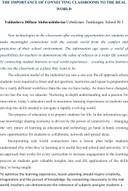THE IMPORTANCE OF CONNECTING CLASSROOMS TO THE REAL WORLD

THE IMPORTANCE OF CONNECTING CLASSROOMS TO THE REAL WORLD
Yuldasheva Dilfuza Abdurashidovna-Uzbekistan. Turakurgan. School № 3
New technologies in the classroom offer exciting opportunities for students to make meaningful connections with the outside world from the comfort and protection of their school environment. The information age opens a world of possibilities for teachers to demonstrate the value of subjects in a wider life context by connecting student interests to real world experiences – creating active learners who see the classroom as a place they want to be.
The education model of the industrial era saw a one size fits all approach where students were required to listen and not question, memorise and repeat in preparation for a vastly different workforce than the one we have today. As times have changed, so too has the way we educate. Nurturing in-depth understanding and a passion for innovation, today’s educators seek to maximise learning experiences so students can develop the skills needed to navigate a rapidly evolving world.
The purpose of education is to prepare students for life. In the information age, our knowledge sharing economy is driven by the power of connectivity – changing the very nature of learning as education and technology go hand in hand, creating new opportunities for students to collaborate, network and spread ideas.
Incorporating real world connections into a lesson plan helps students understand why what they’re learning at is useful beyond school and university. It’s an approach that works for every curriculum to increase engagement in the learning process as students gain valuable insights into real life applications of the skills they’re being taught.
To optimise the learning experience, lesson planning should inspire creativity, imagination and the pursuit of knowledge. By connecting classrooms to the real world, teachers can demonstrate the relevance of subjects and give students a vision of what’s possible – providing a meaningful framework for both academic and personal development.
Multimedia activities offer a rich context for structured learning as well as alternative teaching methods. Bringing material to life through news feeds, podcasts and streaming videos opens the classroom up to a wider world where students can start to see the value of learning.
Increasing engagement through interactive education technology encourages students to become better learners, empowering self-initiated learning as they take an interest in what’s going on around them and actively seek to satisfy their own curiosities.
Leveraging new media to ignite the desire to learn benefits students across all levels of academic achievement and ability. By connecting them to a bigger picture, we can set the next generation up for success not just at school but in life as they explore information that speaks to them and find new ways to relate to each other and the world.
Connecting education beyond the school experience, here are some ideas for how you can take your lessons beyond the classroom and into the real world:
1- Get current
Incorporating current affairs into the classroom creates a more engaging lesson – helping students become aware of global issues and allowing them to make connections between what is being taught at school and what is happening in the real world. Benefiting from a wide range of cultural, social and political perspectives they may not otherwise be exposed to, students who are encouraged to keep up with the latest news develop a more responsible outlook and are better prepared to operate in a globalised and multi-cultural economy.
2- Use technology
A recent study found that students spend an average of 30 minutes on their mobiles during class. Rather than ban devices, why not incorporate technology into the classroom? In the workplace, phones and other technologies are readily used – so it makes sense that learning how to manage them and get the most out of what they can do should start in schools to prepare them for their future in a technology driven world. Consider getting students to conduct research using their phones, or incorporate online learning resources as part of the lesson.
3- Encourage group work
Working in teams replicates the workplace for most professions so it’s beneficial for students to get used to collaboration in the classroom. Problem-based exercises that provide shared learning experiences are an opportunity for students to learn through discussion, clarification and evaluation of ideas – with studies showing that students who connect with each other and wider communities through social learning attain higher level thinking and preserve information for longer than those working on their own.
4- Teach authentic engagement
Instead of teaching students to regurgitate information, teach them how to find it. In the age of Google students don’t need to remember facts the way they did under an industrial era education model – what they need to know now is how to analyse and evaluate the information that they are presented with. Media literacy is an essential 21st century skill, showing students how to differentiate between fake news and credible resources so they can make more informed decisions to shape their understanding and contribution to the world.
What we need in our future workforce are students who understand the world and how it works. Connecting classrooms to the real world requires the education system to responsibly integrate technology into the academic curriculum in order to equip students with the tools they need to meet the demands of a knowledge-driven society.
One challenge to this can be the access to shared media resources, however there are solutions such as Fairfax digital newspapers that can be easily referenced as part of classroom activities.
© ООО «Знанио»
С вами с 2009 года.
![]()

